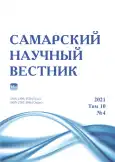Samara banner as a cultural code
- Authors: Vasiliev V.V.1, Kozlovskaya G.E.1
-
Affiliations:
- Samara Branch of Moscow City University
- Issue: Vol 10, No 4 (2021)
- Pages: 225-229
- Section: Historical Sciences and Archaeology
- URL: https://journals.rcsi.science/2309-4370/article/view/104923
- DOI: https://doi.org/10.17816/snv2021104215
- ID: 104923
Cite item
Full Text
Abstract
The paper deals with the phenomenon of the Samara banner as a cultural code. It is emphasized that the period of the second half of the 19th – early 20th centuries is increasingly considered by researchers as a source of elements transmitted and perceived as modern cultural codes. Epistemological, psychological, sociological and information-communication approaches to understanding cultural codes are presented, with the help of which ideas about the unity, cohesion of society are formed and the social uncertainty of modernity is reduced. The period of the Russian-Turkish war is characterized as a period of the cultural code formation associated with the activation of national self-identification, growth of patriotism, formation of civil consciousness and civil society. The process of formation and consolidation of the cultural code inherent in the modern inhabitant of the Samara province, which was influenced by notable socio-political, cultural and religious events of both the past and the present, is analyzed. Dynamics is noted in assessing the role of the Samara Banner phenomenon for various periods of Russian history. The authors give an example of systemic involvement of the younger generation of the Samara Region residents in the history of their native land, through acquaintance with the history of the Samara banner, presented in the textbooks «Stories on the history of the Samara Region» and «History of the Samara Region».
Full Text
##article.viewOnOriginalSite##About the authors
Vladimir Viktorovich Vasiliev
Samara Branch of Moscow City University
Email: vasilev-429@mgpu.ru
candidate of historical sciences, associate professor of History, International Law and Foreign
Russian Federation, SamaraGalina Efimovna Kozlovskaya
Samara Branch of Moscow City University
Author for correspondence.
Email: kozlovskayage@mgpu.ru
doctor of historical sciences, professor of History, International Law and Foreign
Russian Federation, SamaraReferences
- Клименкова А.M. Культурные коды как факторы формирования ценностных ориентаций // Вестник РУДН. Серия: Социология. 2013. № 2. С. 5–12.
- Жукоцкая А.В. Концепт «советскости» в пространстве мифологии и идеологии // Проблемы распада и наследия СССР в современном публичном пространстве: сб. науч. ст. всерос. науч.-практ. конф. с междунар. участием, Москва, 19 апреля 2021 года. М.: Книгодел, 2021. С. 161–169.
- Рапай К. Культурный код. Как мы живем, что мы покупаем и почему. М., 2019. 234 с.
- Штомпка П. Социология. Анализ современного общества / пер. с польск. С.М. Червонной. М.: Логос, 2005. 664 с.
- Аншаков Ю.П., Шепелева А.Ю., Толкачев М.В. Русская православная церковь в освободительной борьбе южных славян в 1875–1878 гг. (на материалах Поволжья) // Известия Самарского научного центра Российской академии наук. Исторические науки. 2021. Т. 3, № 3 (11). С. 25–33. doi: 10.37313/2658-4816-2021-3-3-25-33.
- Ценов Й. Знамя и губернатор. Самарское знамя и Петр Владимирович Алабин // Самарский край в истории России: мат-лы межрегион. науч. конф., посв. 180-летию со дня рожд. П.В. Алабина, Самара, 16–17 сентября 2004 года. Самара: Самарский областной историко-краеведческий музей им. П.В. Алабина, 2004. С. 69–132.
- Кабытов П.С. Легендарный самарец Петр Владимирович Алабин. Куйбышев: Всероссийское общество охраны памятников истории и культуры, Куйбышевское областное отделение, 1990. 58 с.
- Белодубровский Е.Б. Самарское знамя [Электронный ресурс] // Федеральный информационно-аналитический журнал «Сенатор». https://senat.org/samarskoe-znamya.html.
- Московский О.В., Козловская Г.Е., Ремезова Л.А. Рассказы по истории Самарского края. Начальное общее образование: учеб. пособие для общеобразоват. организаций. М.: Просвещение, 2019. 124 с.
- История Самарского края. Основное общее образование: учеб. пособие для общеобразоват. организаций. В 2 ч., ч. 2 / А.И. Репинецкий, А.В. Захарченко, Г.Е. Козловская, Л.А. Ремезова. М.: Просвещение, 2019. 191 с.
Supplementary files






